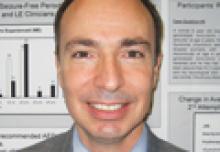SEATTLE—After a failed first attempt to discontinue antiepileptic drugs (AEDs) in a child with epilepsy, many pediatric epileptologists require the patient to be seizure-free for a longer period before making a second attempt at AED discontinuation, according to data presented at the 68th Annual Meeting of the American Epilepsy Society.
Researchers surveyed 94 American and Canadian pediatric epileptologists by e-mail in 2014 and asked about their usual approach to weaning patients off AEDs. In addition, the researchers presented the epileptologists with real-life cases in which discontinuation of AEDs might be more difficult.
A majority of epileptologists required children to be seizure-free for two to three years before a first attempt at AED discontinuation (62%) and before a second attempt at discontinuation (62%). Responses varied considerably, however.
Overall, neurologists tended to require a longer seizure-free period before the second attempt at discontinuation, compared with the first attempt. The proportion of epileptologists requiring less than two years of seizure freedom decreased from 38% to 21% between the first and second attempts. The proportion of neurologists requiring three or more years increased from 0% to 17% between the first and second attempts.
This shift was greater among epileptologists who were more experienced, which was defined as having practiced pediatric epilepsy for at least 10 years after finishing a fellowship. Approximately 56% of more experienced epileptologists required a longer seizure-free period before the second attempt, compared with 26% of less experienced epileptologists.
Neurologists disagree about how to perform a second attempt to discontinue AEDs, said Ignacio Valencia, MD, an attending neurologist and Associate Professor of Pediatrics and Neurology at St. Christopher’s Hospital for Children in Philadelphia. “Epileptologists in general are more cautious the second time, and even more so the people who have more experience, compared to the less experienced.”
The American Epilepsy Society has provided no guidelines or statements about how to wean children off AEDs the second time, he added. Investigators will need to analyze the characteristics of second attempts and patient outcomes. The results could prompt one of the epilepsy societies to draft a consensus statement or recommendation for people who treat children with epilepsy about how to make a second attempt at AED discontinuation, said Dr. Valencia.
The more experienced epileptologists likely wait longer because “they have been burned before. They know for a fact that when they wean earlier, the kids have a seizure again. They have been burned and they are probably more cautious and conservative the second time.”
Overall, the epileptologists ordered more EEGs and more AED levels (but not more MRIs) before a second attempt than before a first attempt. The epileptologists also tapered the drugs more slowly during the second attempt.
After the first attempt, epileptologists viewed various factors, syndromes, and etiologies as more unfavorable to AED discontinuation the second time around. These unfavorable factors included polytherapy, age younger than 2 at seizure onset, and focal seizures.
For example, “benign Rolandic epilepsy is still viewed as a favorable factor, but it moves down from the first attempt to the second attempt, making it a little less favorable the second time,” Dr. Valencia noted.
—Susan London


